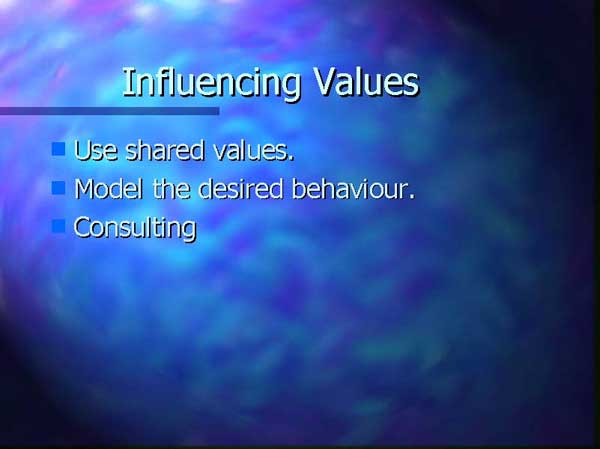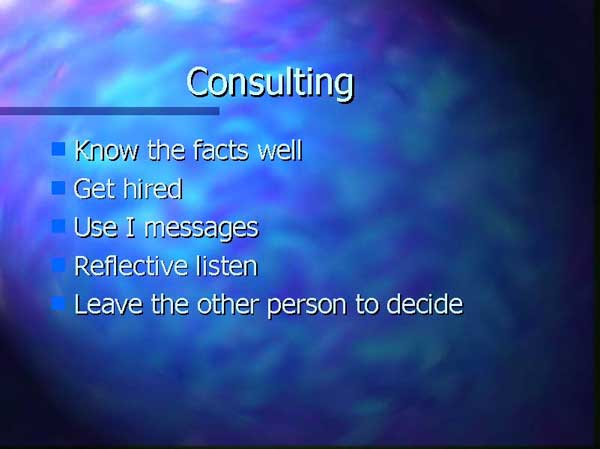WordPress database error: [Table 'adding_b51201.wp_SBConfiguration' doesn't exist]select * from wp_SBConfiguration where id='1'
Welcome to Module 9.2 Return to Dashboard
To make the following explanation useful, choose someone whose values you want to influence in some way. I want to get you to consider three skills which embody the qualities you have just discovered.
Values are our opinions about what is important (or ‘valuable’) and what isn’t. If you are interested in building a relationship with someone, one of the most powerful things is to find at least one value which you and they share. Once you know what that is, you can plan together ways to express that value.

I’m sure you’ve used this principle before. Say, you’re going over to a friend’s place. This friend has a 6-year-old son and you really want to get on well with this kid. What would you do? Probably you’d find out what he’s interested in – what he values. Perhaps it’s computer games, chewing gum, and musical instruments. You may not like chewing gum or music, but you’ve played a few video games in your time and enjoyed that. Video computer games are a shared value. If you want to get on with your friend’s son, you’d plan a way to spend time together expressing that value.
In 1990, Reckitt and Coleman put out a new group of household cleaners called “Down To Earth”. Although these cleaners were sold in non-returnable plastic bottles, they were advertised as taking good care of the environment. Their contents were biodegradable and not tested on animals. Why did this major company put out a whole new range of cleaners? Because they recognised the growing power of a new 1990s value – ‘care for the environment’. All advertising appeals to shared values. ‘Coke adds life, and everybody wants a little life.’ ‘Good time, great taste … of McDonalds.’
If you’re trying to befriend, or even to persuade someone, you can use this same principle. Say you want to convince a 14-year-old not to smoke cigarettes. Will it work to discuss the risk of her getting a heart attack in her thirties? Probably not. You’d be better talking about how the smell of cigarettes can turn off potential friends. You need to find a shared value.
In their book Reframing, Richard Bandler and John Grinder give an interesting example of their use of shared values to resolve a conflict over non-shared values. A father has just told his daughter ‘If you don’t listen to me and don’t come home by 10 o’clock, I’ll ground you for a week…’. After checking that this message (a ‘You message’ and ‘a threat to use power’) doesn’t get a very good response from the daughter, Bandler and Grinder ask the father what the value is behind his command.
He replies “Well, I care. I don’t want her hanging out with hoods. I don’t want her out in the street. There’s dope out there. I want her to be in the house, safe and sound. She’s my girl, and I want to make sure that she has the kind of experiences that she needs to grow up like I want her to grow up.” The daughter explains her values: “But it’s my life!”
Bandler and Grinder then point out a value that both of these people share. “OK, Sam. Is part of that image that you have of your daughter growing up for her to be independent? Do you want her to be a woman who knows her own mind, who can stand on her own two feet and make decisions for herself based on the realities of the world? Or do you want her to be pushed around by other people’s opinions?”
Once these two people realise that they share the value of ‘independence’, they will probably find more useful ways to behave. In a sense, they want the same thing, only their methods differ. The father may now be willing to alter his way of discussing the matter, the daughter may be willing to alter her evening pattern. They may, in fact, be prepared to resolve the problem using the win-win method.
Think of that person whose values you want to influence. What is an example of one value that the two of you share. Consider now how you could build your relationship more fully on that value, and how that would change the values conflict you have had.
However, in most conflicts over values issues, at least one person will not be prepared to negotiate a win-win solution. This is because they do not believe it’s the other person’s business to discuss this issue. As Sam’s daughter (above) said, ‘But it’s my life’. In this case the person does not believe that their behaviour has any concrete effect on the other person.
Sam may send his daughter a nice clear I message (‘When you arrive home after 10 o’clock I get really worried that you’ve been hurt”) and she just says “You worry too much dad. Perhaps you could talk to a counsellor about it”. What can he do? The real questions are, “How important is this relationship to him?” and “How important is it to him that he actually change his daughter’s value?” If his relationship is not as important as stopping her going out, he could use power. The use of power over her (eg. ‘grounding’ her) will damage their relationship.
The use of power also has very little effect on her values. Sure, it stops her going out. But it doesn’t stop her wanting to go out. Power only changes what people do, not what they value. Nonetheless, the danger may seem serious enough to make it worth using power. What could he do if he really wanted to influence her?
The next powerful skill for influencing someone’s values is modelling.
Modelling simply means demonstrating, by your own actions, that what you value works. Practise what you preach, may be a well-known saying, but it’s fascinating how many people ignore this truth in their daily life. Teachers who routinely smoke in their staff room give out detentions to students caught smoking in the school toilets. Parents who make a practice of lying about their motives (‘I’d like to give you a donation, but I have to go to the bank,” and so on) tell their kids not to lie. A man who ends family arguments by punching his wife tells his kids to control their temper.
If your values really work for you, others will adopt them. This is particularly so if you have a good relationship with those people. People tend to copy the values of those they admire. Notice how often a husband and wife end up with similar opinions, or a group of friends all wear the same style clothes. When a collection of much admired rock musicians runs a concert to aid famine victims, hundreds of thousands of their fans donate money. If you remember a teacher you really admired from earlier in your life, you can probably recall right now some of the ways you used that teacher as a model.
Consider that person whose values you would like to influence. How could you yourself more fully express and demonstrate the value you want them to take on board? Consider how that could change their own value as they observe you living with the value you have.
The other main choice for influencing values is Consulting, which we practised last module, and will carry on practising today. Remember that good consulting depends on 5 things:
- That I know the facts about my issue
- That the other is willing to listen – to “hire” me
- That I share my opinions respectfully, using I Messages
- That I listen to the other’s opinions using reflective listening, and
- That I leave the final decision to the other, and don’t “hassle”.
The main reason people try to influence others’ values is to help those others. That is, they are motivated by love. Consulting and modelling give you ways to share your values with love, instead of creating conflict with the very person you care for. If, after time, your attempts to influence someone are not working, you might ask yourself: ‘Is that so terrible? Can I not live my values and allow them to live theirs?’
In some cases, you may decide to change your relationship to allow for your different values, as the best solution that can be achieved. For a non-smoker and a smoker this might mean agreeing on a separate area where the smoker can continue their habit. For two people with strongly opposed political beliefs it may mean agreeing not to discuss certain topics. For a wife who cannot accept her husband’s active alcoholism it may mean living separately.

In other cases, you may discover that it is possible to continue your relationship exactly as it is, and simply by adopting a different attitude to your difference, come to feel more accepting of it. Is any of us so absolutely certain of our map of the world that we can insist all others follow?
There is another fun activity you can do with a friend that will clarify these choices for influencing values or dealing with conflicts of values. Get the instructions here.
And here’s one last activity that will demonstrate the power of consulting.
And this is the end of the Transforming Communication course. As you have come this far with me, you will have learned many new skills, and you may have discovered new ways of thinking about your relationships. And notice, too, that some of your relationships are starting to change, as you are changing, now.
Congratulations on completing the course and having the courage to take responsibility for your relationships.
And I’m sure you are curious to learn the end of the story …